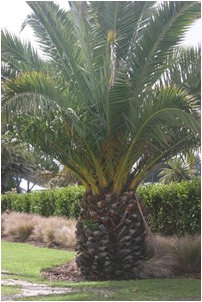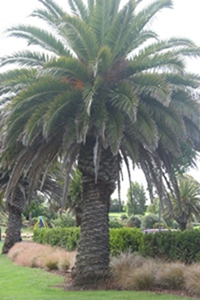|
They lend an air of bohemian sophistication to our local environment but have you ever wondered about our beautiful palm trees? We are used to seeing them everywhere, they grow along the paths at the Caroline Bay and feature in peoples gardens throughout our town.
The species originates from The Canary Islands and its correct name is Phoenix Canariensis, the Canary Island Date Palm, they are often referred to as Pineapple palms or Phoenix palms. The palm is easily recognized through its crown of leaves and trunk characteristics. When pruned, the bottom of the crown, also called the nut, appears to have a pineapple shape. It grows as a large solitary palm reaching between 10–20m in height. I’ve been trying to find out a little about their history in our town. A helpful email arrived from our museum volunteers and staff detailing work carried out when Caroline Bay was first being developed and landscaped. The article was dated 30/9/1939 and titled ‘Work At Bay.’ The only reference to palms being planted was in the following sentence. ‘ Further along on the north side of the pavilion there are other recessed seats, and hardy palms have been planted on the bank above’. That gives us the year 1939, when they were first recorded as having been planted here aging the biggest ones at around 70-80yrs old. Recent landscaping on the Bay has seen more planted bordering the newest paths and although there are a few in Oamaru, Timaru is generally considered to be the southern most situation that they will grow successfully in. They are definitely a feature plant and if you are planning to plant one at your place, make sure it has plenty of room to grow in a permanent open position and warn the kids not to play to close by. Local landscapers often get calls to shift them for replanting elsewhere. They can be successfully moved but it is an expensive exercise when they are fully grown. They are fabulous looking but not without their problems and there are a number of injuries annually that come from the rather nasty spikes on the branches. You might be interested to know that New Zealand's Landcare Research has classified the palm as a 'sleeper weed' - "a plant that spreads slowly and goes unnoticed until it becomes widespread”. Karen Rolleston
0 Comments
Leave a Reply. |
View by date Archives
February 2021
Categories |
|
|





